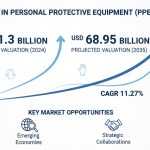Methanol Market Projected to Reach USD 96.6 Billion by 2035 Amid Rising Demand from Energy, Automotive, and Chemical Sectors
The global Methanol Market, a versatile industrial chemical and emerging clean fuel, is set for significant expansion. Widely used across energy, automotive, construction, and chemical industries, methanol plays a vital role in producing formaldehyde, acetic acid, MTBE, biodiesel, and olefins. In 2024, the market size stood at USD 35.4 billion and is projected to reach USD 96.6 billion by 2035, growing at a CAGR of 9.6% between 2025 and 2035.
Our comprehensive Methanol Market report is ready with the latest trends, growth opportunities, and strategic analysis. View Sample Report PDF.
Key Takeaways
- Asia Pacific dominated in 2024, driven by China and India’s high consumption in energy and chemical feedstocks.
- Energy & fuel applications are expected to grow the fastest, with methanol increasingly recognized as a clean-burning fuel alternative.
- Chemical feedstock use remains the largest segment, particularly in formaldehyde, acetic acid, and methanol-to-olefins (MTO).
- Growing investments in green methanol production (bio-methanol and e-methanol) are creating sustainable growth opportunities.
Premium Insights
The methanol market is expanding rapidly due to rising global energy transition needs, petrochemical demand, and the adoption of methanol as a low-carbon marine and automotive fuel. Methanol’s versatility as both a fuel and a chemical building block makes it critical for diverse industries. However, the market faces challenges such as natural gas price fluctuations, supply-demand imbalances, and environmental concerns. Increasing investments in renewable methanol are expected to reshape the industry landscape over the coming decade.
Key Market Trends & Insights
- Green Methanol Growth: Surge in bio-methanol and e-methanol adoption, especially in marine shipping and power generation.
- Petrochemical Integration: Rising demand for acetic acid, formaldehyde, and olefins sustains methanol’s position as a key chemical feedstock.
- Energy Applications: Methanol blends and methanol-to-gasoline processes are gaining traction as alternatives to conventional fuels.
- Technological Innovation: Expanding methanol-to-olefins (MTO) projects in Asia drive large-scale demand.
The global Methanol Market is valued at USD 35.4 Billion in 2024 and is projected to reach a value of USD 96.6 Billion by 2035 at a CAGR (Compound Annual Growth Rate) of 9.60% between 2025 and 2035.
The industry is moderately fragmented, with players focusing on production capacity expansions, renewable methanol initiatives, and strategic partnerships. Competitive advantages depend on access to cost-efficient feedstocks, advanced production technology, and integration across value chains.
For Methanol Market Research Report and updates detailed: View Full Report Now!
By Feedstock
- Coal (28.5%): Coal remains a significant methanol feedstock, especially in China, due to abundant reserves and cost advantages.
- Natural Gas (59.2%): Dominates the market as the most economical and efficient feedstock, widely used in North America and the Middle East.
- Biomass (12.3%): Gaining traction as a renewable feedstock for green methanol production to support decarbonization goals.
- Municipal Waste: Emerging as a sustainable pathway for circular methanol production and waste-to-energy applications.
- CO₂: Innovative technology converts captured carbon into methanol, aligning with global carbon neutrality targets.
- Other Feedstocks: Includes naphtha and unconventional sources, contributing to regional diversification of supply.
By Derivatives
- Gasoline: Methanol-blended fuels support cleaner combustion and reduce reliance on conventional gasoline.
- Formaldehyde: One of the largest derivatives, used in resins, adhesives, and wood-based construction materials.
- Methyl Tertiary Butyl Ether (MTBE): Improves octane levels in gasoline, widely used as a fuel additive.
- Acetic Acid: Essential for packaging, textiles, and plastics production, driving steady methanol demand.
- Dimethyl Ether (DME): A clean-burning fuel alternative and LPG substitute with growing adoption in Asia.
- Methyl Methacrylate (MMA): Used in coatings, adhesives, and acrylic plastics for automotive and construction.
- Chloromethane: Key intermediate for silicones, refrigerants, and pharmaceuticals.
- Other Derivatives: Includes solvents and intermediates supporting diverse industrial applications.
By Sub-Derivatives
- Polyethylene Terephthalate (PET): Widely used in packaging, especially bottles and films, driving demand from beverages and FMCG.
- Acetic Anhydride: Crucial for pharmaceuticals, textiles, and cellulose acetate in cigarette filters.
- Dimethyl Terephthalate (DMT): Used in polyester resins, films, and textiles, supporting the packaging sector.
- Methyl Methacrylate (MMA): High demand in transparent plastics, coatings, and electronics applications.
- Methyl Amines: Serve as intermediates in agrochemicals, pharmaceuticals, and water treatment chemicals.
- Methyl Chloride: Integral to silicone production and various specialty chemicals.
- Other Sub-Derivatives: Include solvents and intermediates for niche industrial uses.
By End User
- Construction: Major consumer of methanol derivatives in paints, adhesives, resins, and insulation materials.
- Automotive: Uses methanol-based fuels, plastics, and coatings for lightweighting and efficiency.
- Electronics: Requires methanol derivatives in circuit boards, plastics, and solvents.
- Paints & Coatings: Methanol derivatives enable durability, finishing, and performance in coatings.
- Pharmaceuticals: Methanol is a feedstock for active pharmaceutical ingredients (APIs) and solvents.
- Refrigeration: Used in coolants and as a feedstock for refrigerant chemicals.
- Other End Users: Includes textiles, packaging, and energy industries adopting methanol and its derivatives.
Regional Insights
North America
North America benefits from abundant shale gas reserves, making natural gas-based methanol production cost-efficient. The U.S. leads regional demand with growing applications in chemicals, automotive fuels, and renewable energy. Rising focus on bio-methanol and methanol blending in gasoline, coupled with strong export capacity, further strengthens its global competitiveness.
Europe
Europe is emphasizing renewable methanol adoption, driven by strict EU sustainability targets and decarbonization policies. The region is at the forefront of green methanol integration in marine shipping, power generation, and industrial applications. Countries like Germany and the Netherlands are investing in advanced methanol technologies to support energy transition goals.
Asia-Pacific
Asia Pacific dominates the global methanol market, with China being the largest consumer due to its massive methanol-to-olefins (MTO) capacity and strong demand from construction, automotive, and energy sectors. India is also emerging as a fast-growing market, driven by rising industrialization and clean fuel adoption. Abundant coal reserves in China and growing investments in green methanol projects are shaping the region’s leadership.
Latin America
Latin America is witnessing steady growth in methanol demand, particularly from automotive fuels, construction, and packaging industries. Brazil, with its strong agricultural base, shows potential for bio-methanol production, while Mexico is an emerging consumer due to rising industrial activity. The region is also exploring renewable energy-based methanol pathways.
Middle East & Africa
The Middle East & Africa region leverages vast natural gas reserves, positioning it as a key methanol producer and exporter. Countries like Iran, Saudi Arabia, and Qatar are expanding methanol capacity to serve global markets. Rising industrialization in Africa and increasing use of methanol as a fuel alternative offer gradual growth opportunities across the region.
Key Methanol Market Company Insights
Key players in the methanol market such as Methanex Corporation, SABIC, Mitsubishi Gas Chemical, OCI NV, Celanese Corporation, Zagros Petrochemical, and Proman AG are focusing on expanding production capacities, integrating renewable methanol projects, and securing long-term supply agreements to strengthen their market positions. Many companies are investing in green and bio-methanol technologies to align with global decarbonization goals and meet the rising demand from shipping, automotive, and chemical industries.
Key Methanol Market Companies
- Methanex Corporation (Canada)
- BASF SE (Germany)
- Celanese Corporation (U.S.)
- Gujarat State Fertilizers & Chemicals Ltd. (India)
- HELM Proman Methanol AG (Switzerland)
- SABIC (Saudi Arabia)
- Yanzhou Coal Mining Co. (China)
- Zagros Petrochemical Company (Iran)
- PETRONAS (Malaysia)
- Mitsubishi Gas Chemical Company Inc. (Japan)
- Mitsui & Co. Ltd. (Japan)
- LyondellBasell Industries B.V. (U.S.)
- OCI N.V. (Netherlands)
- Metafrax Chemicals (Russia)
- SIPCHEM (Saudi Arabia)
- SABIC (Saudi Arabia)
- Ningxia Baofeng Energy Group Co. Ltd. (China)
- Lyondellbasell Industries Holdings BV (U.S.)
Recent Developments
- May 2021: Evonik Mitsubishi Gas Chemical Company has started commercial Methanol production from woody biomass. The move is a part of the companys efforts to expand its sustainable chemical business.
- April 2021: Methanex Corporation, the worlds largest producer of Methanol, announced that it had restarted its two production plants in Louisiana, which were shut down due to the impact of Hurricane Laura and subsequent freezing weather in February.
- February 2021: Celanese Corporation, a global chemical and specialty materials company, announced a price increase for Methanol in North America. The price hike reflects the tight supply and demand situation in the market.
Market Dynamics
Driver
The methanol market is primarily driven by its versatility as both a fuel and chemical feedstock. Rising demand from petrochemicals, construction, and automotive industries, coupled with its growing use in energy applications such as marine fuel and power generation, is fueling growth. Additionally, increasing adoption of methanol-to-olefins (MTO) technology in Asia and the global shift toward low-carbon fuels further strengthen market expansion.
Restraint
One of the key restraints for the methanol market is feedstock price volatility, particularly natural gas and coal, which significantly impact production costs. Environmental concerns related to CO₂ emissions from conventional methanol production also pose regulatory and compliance challenges. These factors increase cost pressures for producers and limit adoption in price-sensitive regions.
Opportunity
The biggest opportunity lies in renewable methanol (bio-methanol and e-methanol), which is gaining momentum as a sustainable solution for decarbonizing shipping, automotive, and power sectors. Supportive government policies, carbon reduction targets, and increasing investment in circular economy solutions such as waste-to-methanol technologies are opening new avenues for long-term growth.
Challenge
A major challenge facing the methanol industry is achieving cost competitiveness and scalability of green methanol production. Current renewable methanol technologies remain capital-intensive and require significant infrastructure investment. Without widespread cost reduction and supportive global supply chains, the transition toward large-scale adoption of green methanol may face hurdles.
Segmentation Insights
By Feedstock
- Coal (28.5%)
- Natural Gas (59.2%)
- Biomass (12.3%)
- Municipal Waste
- CO2
- Other Feedstocks
By Derivatives
- Gasoline
- Formaldehyde
- Methyl Tertiary Butyl Ether (MTBE)
- Acetic Acid
- Dimethyl Ether (DME)
- Methyl Methacrylate (MMA)
- Acetic Acid
- Chloromethane
- Other Derivatives
By Sub-Derivatives
- Polyethylene Terephthalate (PET)
- Acetic Anhydride
- Dimethyl Terephthalate (DMT)
- Methyl Methacrylate (MMA)
- Methyl Amines
- Methyl Chloride
- Other Sub-Derivatives
By End User
- Construction
- Automotive
- Electronics
- Paints & Coatings
- Pharmaceuticals
- Refrigeration
- Other End Users
Frequently Asked Questions
Q1. What is the global methanol market worth?
The market was valued at USD 35.4 billion in 2024 and is projected to reach USD 96.6 billion by 2035, growing at a CAGR of 9.6%.
Q2. Which application dominates the methanol market?
Chemical feedstock applications dominate, with methanol serving as a building block for acetic acid, formaldehyde, and olefins.
Q3. What is the fastest-growing application?
Energy & fuel applications are the fastest growing, driven by clean fuel demand in shipping and power sectors.
Q4. Which region leads the global methanol market?
Asia Pacific holds the largest share, led by China’s large-scale consumption in chemical and energy industries.
![[Market Research Reports] – Research Google News Blog | VMR.Biz](https://www.vmr.biz/wp-content/uploads/2022/12/logo-removebg-preview.png)











